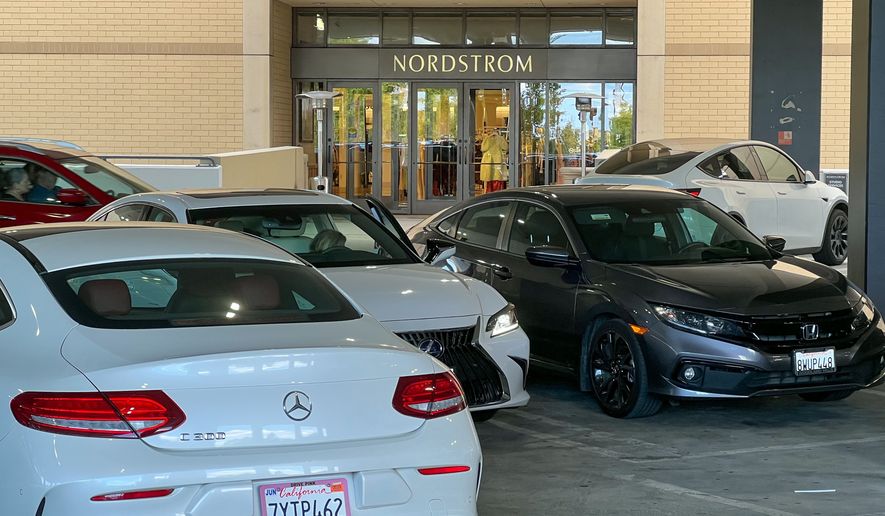The flash-mob robbery at a Nordstrom store in Los Angeles over the weekend is just the latest in a string of brazen thefts, and experts say the incidents will continue until thieves are caught.
Hordes of shoplifters made off with an estimated $400,000 in merchandise during two high-profile heists within a week in the California metropolis and dispersed before police could catch them.
Authorities said a mob of 30 to 50 people descended on the Nordstrom store at the Westfield Topanga shopping mall Saturday and swiped clothes, bags and other goods before sprinting to getaway vehicles without license plates.
Two security guards who confronted the shoplifters were doused with bear spray, police said.
Police estimate the loss at $60,000 to $100,000. No arrests have been reported.
Days earlier, looters stole $300,000 worth of merchandise from an Yves Saint Laurent store in Glendale, north of Los Angeles.
An employee from a nearby store told local Fox affiliate KTTV that 30 thieves raided the business in less than a minute before they ran to idling getaway vehicles. No arrests have been reported.
Look for the trend of “flash robs” to grow until thieves are caught and prosecuted, said Anthony Rodriguez, director of the Social Media in Law Enforcement Conference.
“These flash-mob robberies are becoming more prevalent because of the success rate of committing these crimes in numbers. It is harder for law enforcement to track down dozens of people rather than one or two suspects,” he told The Washington Times.
He said police departments must train officers to monitor and get ahead of publicly posted content online that may relate to crime or violence.
The criminal activity has roots in the peaceful flash mobs that became a cultural phenomenon more than a decade ago when groups gathered to perform choreographed dances, for example.
“Flash robs” were reported as early as 2011.
What has changed since the onset of the COVID-19 pandemic is that luxury retail stores are being targeted:
• A group of juveniles in the District of Columbia set off a smoke bomb and raided the city’s Chanel store in February, police said.
• New York authorities said a group of teens took more than $10,000 worth of clothing from the AVA Galerie in May.
• A mob of at least 80 people pillaged the Louis Vuitton store in San Francisco in 2021.
• One man was arrested in Chicago last year as part of a flash mob that stole $46,000 in merchandise from a Prada store.
Some stores have changed entry and exit policies because of the brazen thefts. The Chanel store in the District has had customers stand in line outside the store. Security guards unlock Chanel’s doors only when a sales associate inside is ready to receive a customer.
Bystanders captured the rampage at Nordstrom on camera and posted footage to social media. Mayor Karen Bass, a Democrat and former member of Congress, condemned the heist. She won the mayoral election last year after promising to address homelessness and crime in Los Angeles.
“What happened today at the Nordstrom in the Topanga Mall is absolutely unacceptable. Those who committed these acts and acts like it in neighboring areas must be held accountable,” she said in a statement. “The Los Angeles Police Department will continue to work to not only find those responsible for this incident but to prevent these attacks on retailers from happening in the future.”
Tracking down people involved in mass thefts can be difficult.
California law enforcement sources have told The Wall Street Journal that the robbers in some cases don’t know one another before hitting a store. Crooks typically broadcast the date and time of a planned heist on a social media app such as Snapchat without revealing participants or organizers.
“This isn’t ‘The Godfather’ by any stretch,” Steve Wagstaffe, the district attorney in San Mateo County, California, told The Journal in 2021. “It’s the modern version of ‘Hey, there’s a party tonight,’ and suddenly you have 100 kids showing up.”
Still, an unidentified LAPD source told Los Angeles Magazine this month that investigators are following up on leads that could link several of the most recent robberies to an organized crew working in Southern California.
Cristine DeBerry, the founder and executive director of the Prosecutors Alliance of California, said the crooks behind the thefts use social media to manipulate hordes of young people into joining the heists.
“Smash-and-grab robberies are the low-hanging fruit for organized crime rings, with sophisticated fencing operations often turning to online platforms like TikTok to recruit young people to supply stolen goods,” Ms. DeBerry told The Washington Times. “To ensure there’s greater accountability, police must implement investigative strategies that target the demand side, the organized fencing rings, and lawmakers must make it more difficult to sell stolen goods online like we did in California.”
Former Los Angeles mayoral candidate Rick Caruso, a Democrat who supported the failed recall effort of District Attorney George Gascon, seemed to take a shot at the local prosecutor last week by saying the robbers are let off the hook. Mr. Caruso owned the Glendale property that thieves hit on Aug. 8.
“The time has come to demand that our elected officials change the laws to hold criminals accountable and start enforcing the laws in a fair and equitable manner,” Mr. Caruso said in a statement Friday. He added later that he heard “directly from small-business owners who feel defeated by the lack of accountability for criminals.”
• Matt Delaney can be reached at mdelaney@washingtontimes.com.




Please read our comment policy before commenting.